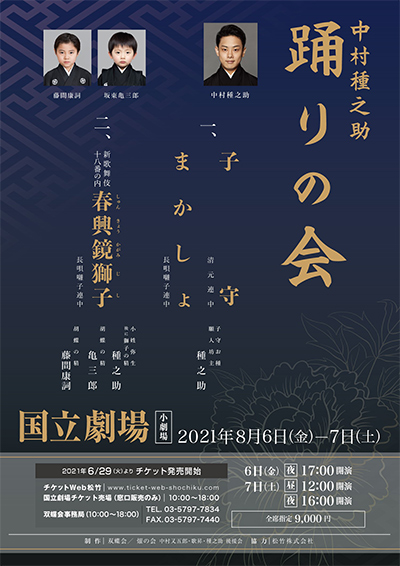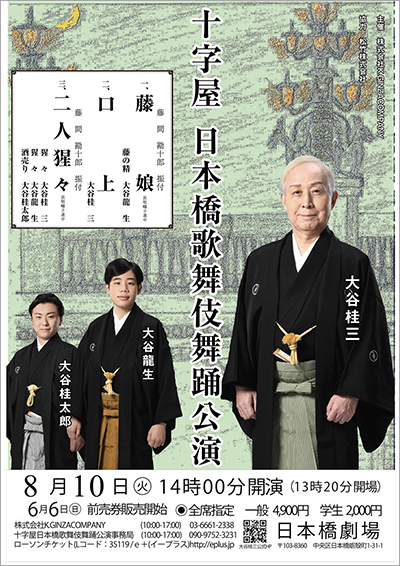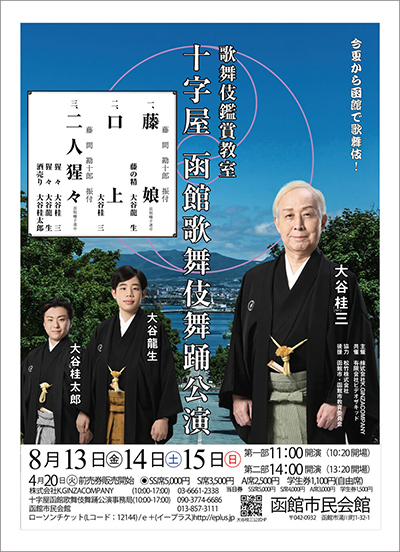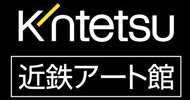| AUGUST 2021 |
| Cancellation of one Kabuki program in August 2021 due to coronavirus (COVID-19)!!! |
|
5 shows in T˘ky˘ (Kabukiza, National Theatre, Nihonbashi K˘kaid˘), 1 in Ky˘to (Minamiza),
|
| Kabukiza (T˘ky˘) |  |
| Dates | 3 ~ 28 August 2021 Hachigatsu Hanagata Kabuki August Young Actors Kabuki |
| 1st program | |
| 2nd program |
Shinkei Kasane-ga-Fuchi (Toyoshiga no Shi) |
| 3rd program | |
| Casting |
Matsumoto K˘shir˘, Nakamura Kankur˘, Nakamura Shichinosuke, Nakamura Jakuemon, Nakamura Senjaku, Ichikawa Ennosuke, Nakamura Kotar˘, Ichikawa Monnosuke, Kataoka Kamez˘, Nakamura Baishi, Band˘ Minosuke, Nakamura Hayato, Ichikawa Komaz˘, Nakamura Yonekichi, Nakamura Kash˘, Band˘ Shingo, Ichikawa Omez˘, Nakamura Kikaku, Matsumoto Kingo, Ichikawa Emisabur˘, Ichikawa Emiya, Ichikawa Somegor˘, Nakamura Tsurumatsu, Nakamura Takanosuke, Ichikawa Danko, Ichikawa Otora, Nakamura Toranosuke, Ogawa S˘ma, Ogawa Hiroharu |
| Comments |
The August Young Actors Kabuki performances at the Kabukiza with Ichikawa Ennosuke in "Kotsuyose no Iwafuji", the Nakamuraya brothers in the kaidanmono "Toyoshiga no Shi" and Matsumoto K˘shir˘ for the second time in his career in "Yoshikata Saigo".
|
 |
|
|||
| Dates | 2 ~ 24 August 2021 Band˘ Tamasabur˘ Tokubetsu Buy˘ K˘en Band˘ Tamasabur˘ Special Dance Performances |
||
| Program | |||
| Casting |
Living National Treasure Band˘ Tamasabur˘, Kawai Yukinoj˘, Nakamura Hashinosuke, Nakamura Fukunosuke, Nakamura Utanosuke |
||
| Comments |
A special Buy˘ program starring the amazing Living National Treasure onnagata Band˘ Tamasabur˘ in Ky˘to at the Minamiza.
|
||
 |
| National Theatre (T˘ky˘) |
| Dates | 6 ~ 7 August 2021 Odori no Kai |
| Program | |
| Comments |
1st edition of a gala starring Nakamura Tanenosuke.
|
 |
| Dates | 13 ~ 14 August 2021 Ne no Kai |
| Program |
Shiki no Yamanba Nank˘ Shin Hashiradate |
| Comments |
23rd edition of the summer program of the association Ne no Kai (literally 'the Sound Association'). The first items in this program are only music performances. The last item is staged under the guidance of Nakamura Ganjir˘ with nadai actors like Nakamura Ky˘z˘, Ichikawa Shinz˘ or Ichikawa Shinjűr˘.
|
| Dates | 18 ~ 22 August 2021 Chigyokai/Kabukikai |
| Program |
Taimen Hana no Harukoma |
| Comments |
27th edition of the common program for 2 associations, the Chigyokai (the Young Fishes Association) and the Kabukikai (the Kabuki Association), which stars stars' disciples in the leading roles of all the items in the program under the guidance of Nakamura Tokiz˘, Onoe Kikunosuke and Ichikawa Danz˘. |
|
|||
| Dates | Sora no Kai |
||
| Program |
??? |
||
| Casting |
Kataoka Matsujűr˘, Kataoka Senjir˘, Kataoka Senju, ??? |
||
| Comments |
The 7th gala of the Sora no Kai (literally 'Sky Society'), in ďsaka at the Kintetsu Art Kan, which stars mostly disciples of the Matsushimaya guild, has been cancelled in 2021. These performances are entitled Abeno Kabuki (Abeno is the name of a famous district in ďsaka). |
||
| National Bunraku Theatre (ďsaka) |
| Dates | 26 ~ 27 August 2021 Kamigata Kabukikai |
| Program |
Futatsu Ch˘ch˘ Kuruwa Nikki (Hikimado) Manete Irodoru Nanatsu Iroha |
| Comments |
31st edition of the Kamigata Kabukikai (the Kamigata Kabuki Association), a summer program in ďsaka which stars Kamigata Kabuki stars' disciples in the leading roles under the guidance of Living National Treasure Kataoka Nizaemon, Kataoka Gat˘ and the dance master Yamamura Tomogor˘ III. |
|
|||
| Dates | 10 August 2021 Jűjiya Nihonbashi Buy˘ K˘en Jűjiya Nihonbashi Dance Performances |
||
| Program | |||
| Casting |
ďtani Keiz˘, ďtani Ryűsei, ďtani Keitar˘ |
||
| Comments |
1st edition of the Jűjiya Dance Gala at the Nihonbashi Gekij˘ (Nihonbashi Auditorium), located within the Nihonbashi K˘kaid˘ (Nihonbashi Community Center). |
||
 |
| Hakodate Shimin Kaikan (Hakodate) | |
| Dates | 13 ~ 15 August 2021 Jűjiya Hakodate Buy˘ K˘en Jűjiya Hakodate Dance Performances |
| Program | |
| Casting |
ďtani Keiz˘, ďtani Ryűsei, ďtani Keitar˘ |
| Comments |
1st edition of the Jűjiya Dance Gala in Hakodate Hakodate Shimin Kaikan (Hakodate City Hall). |
 |
|
|
| Contact | Main | Top | Updates | Actors | Plays | Playwrights | Programs | Links | FAQ | Glossary | Chronology | Illustrations | Prints | Characters | Derivatives | Theaters | Coming soon | News |

